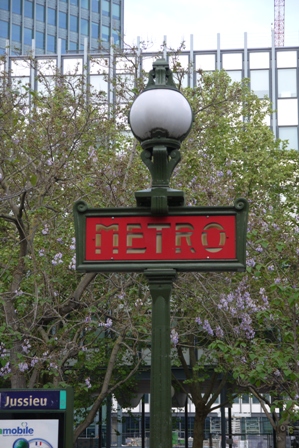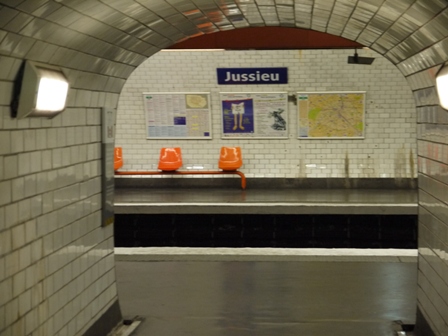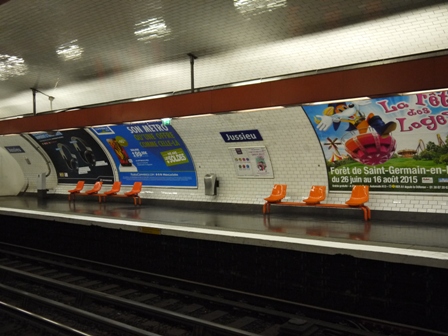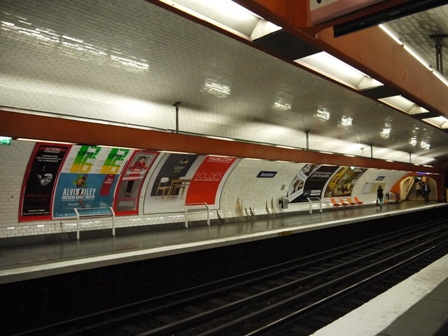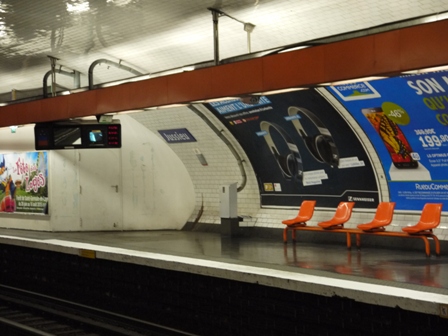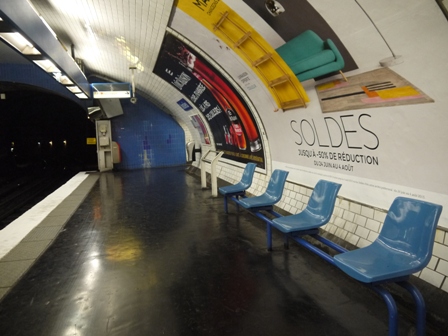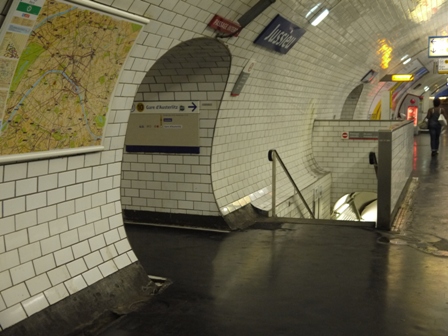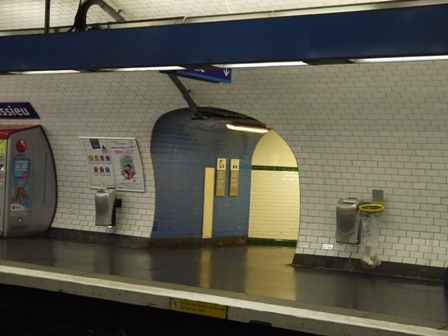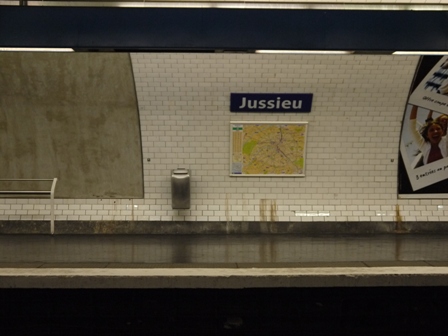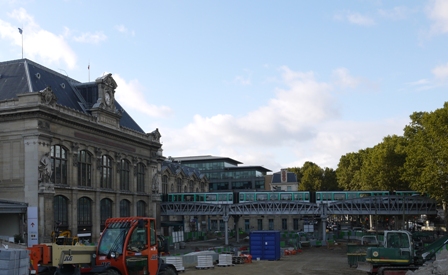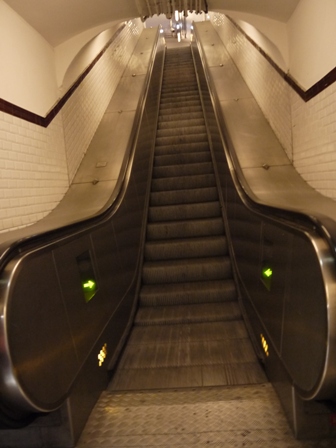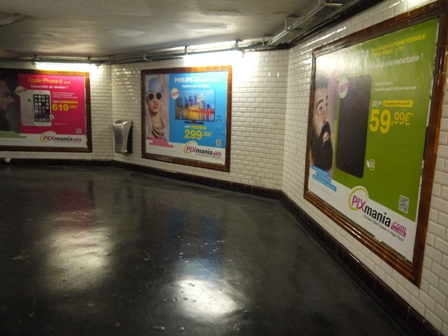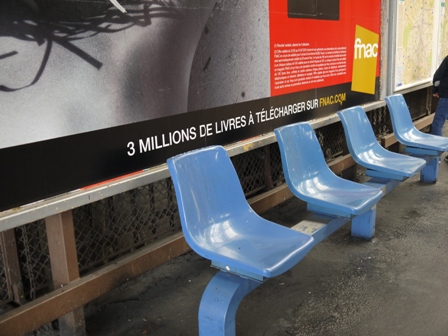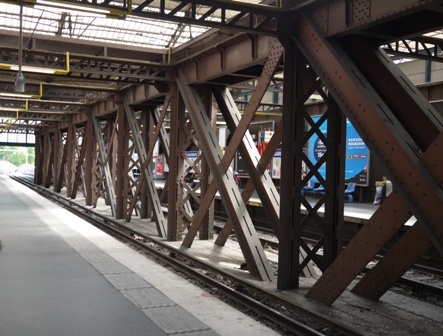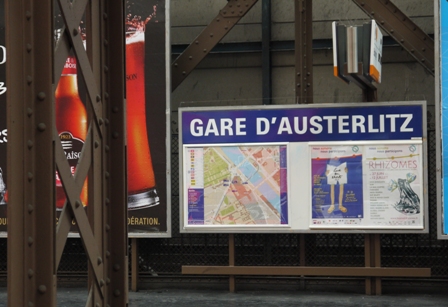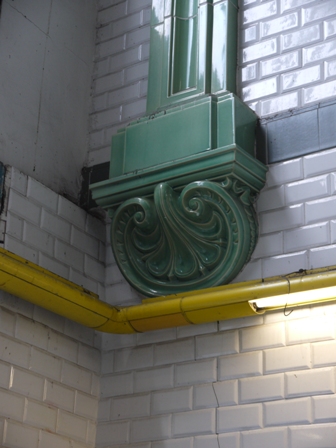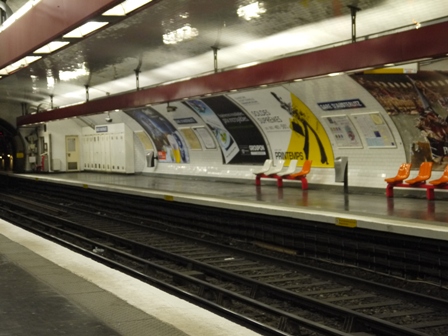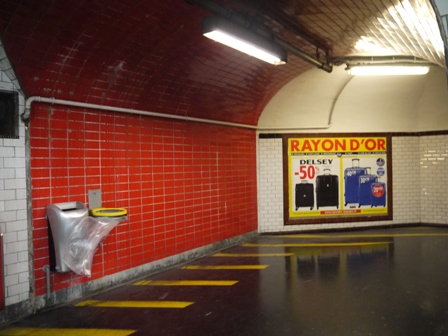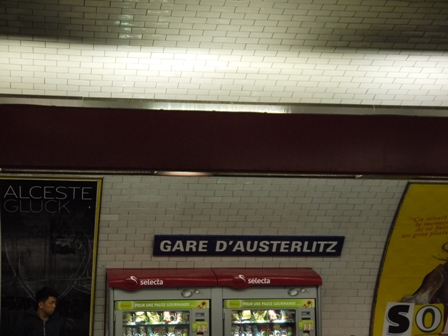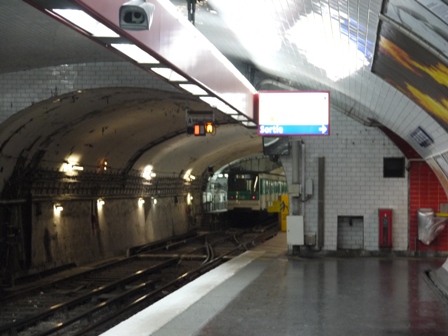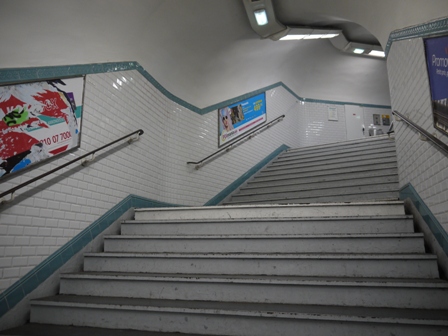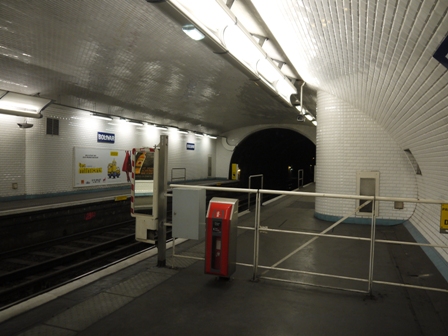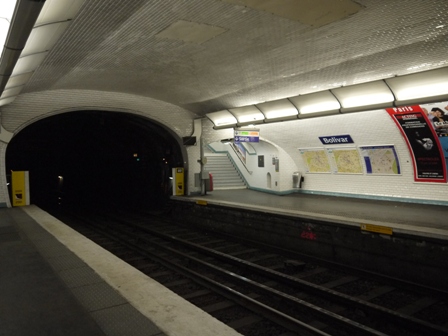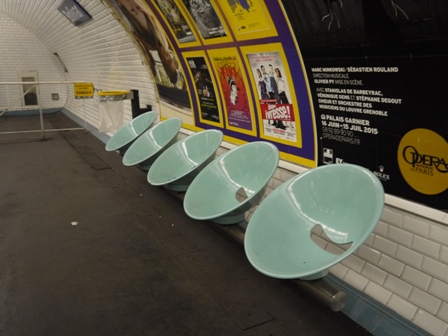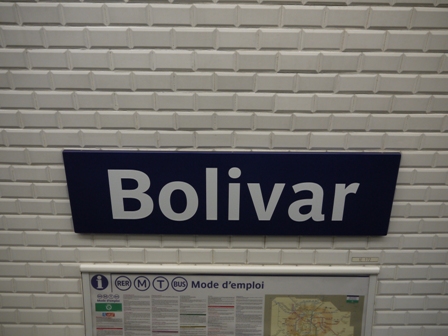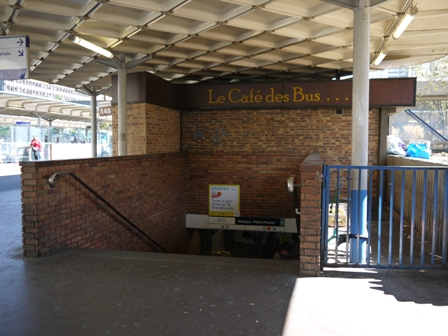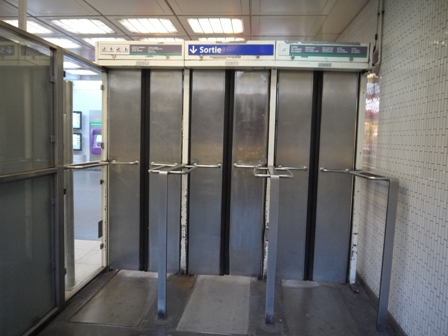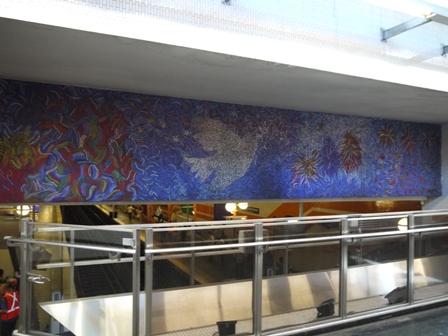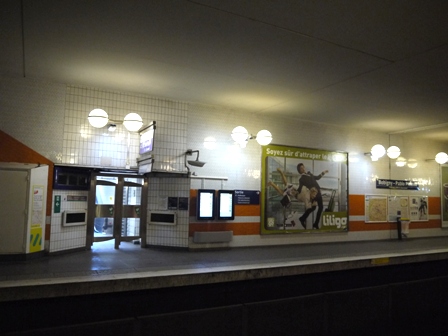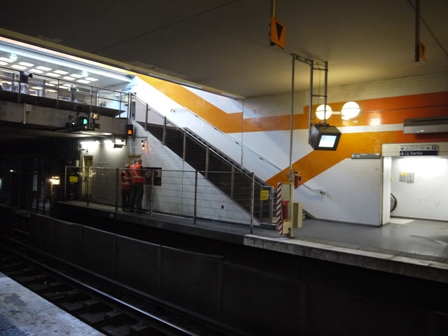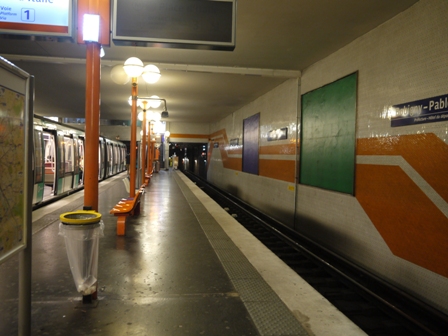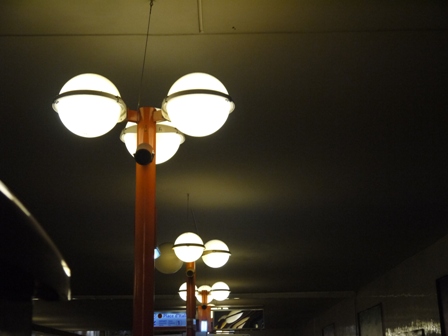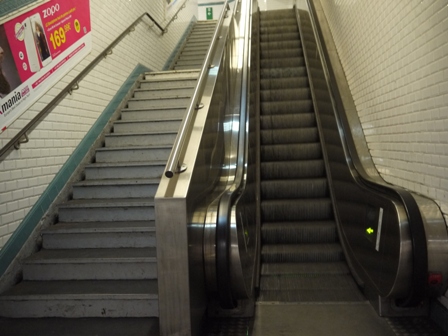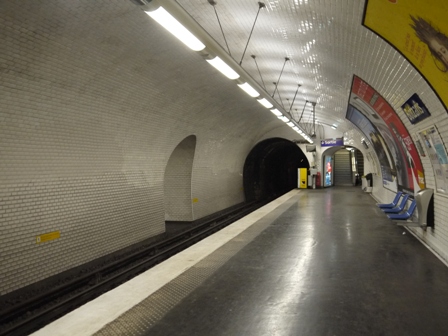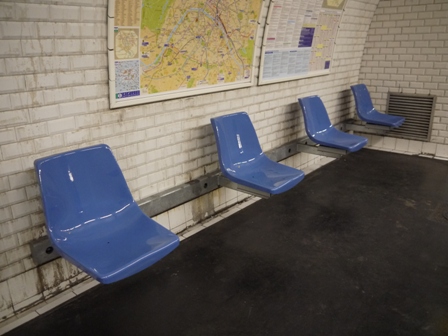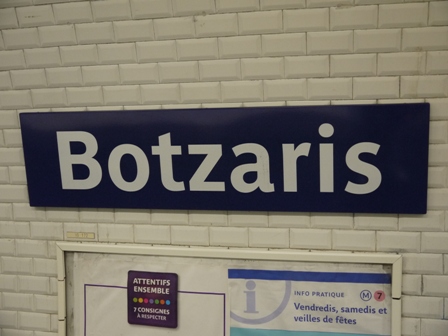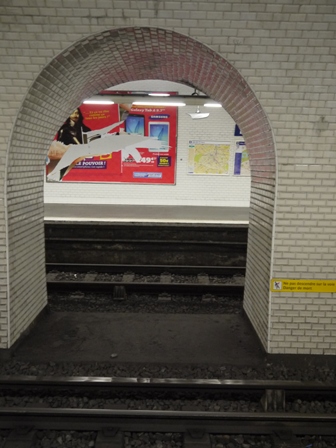- Details
The station opened on 26 April 1931.
It is situated in the 5th arrondissement. The station is named after the de Jussieu family, of which several family members were associated with the nearby botanic garden.
It is an underground station served by the metro lines 7 and 10.
The signpost outside the station is designed by Dervaux. The metro sign on the green post is red, with a couple of small scrolls on top. It will be lit during darkness. The white round lamp is fixed to it with geometric shaped bars.
Short link corridor from the platform of line 10 to the platform of line 7 in direction Ivry/Villejuif. The corridor is very narrow and one-way only. It is completely tiled. Due to the low ceiling height, two lights are placed on the walls rather than above.
Platform line 7
Line 7 started operation on 26 April 1931.
The vaulted ceiling and the walls are tiled in white, flat tiles, which have been placed horizontal.
The orange metal light casing is one rectangular box running from end of the platform to the end.
View of the platform in the other direction.
The tracks are between the two platforms and have no barriers.
The platform has orange plastic chairs, as well as bars to lean against.
The drivers can overview the platform and tracks with two monitors hanging from the ceiling.
Seating is provided in form of orange plastic seats fixed to orange bars on the floor.
Platform line 10
Line 10 started operation on 26 April 1931.
Light blue plastic seats are fixed on two blue metal tubes and placed in front of the advertising boards, which are in metal frames.
The wall at the end of the platform is tiled in blue.
The vaulted ceiling is tiled.
Link corridor from the platform of line 7 and entry to the platform. Signs above each forbid entry.
The beginning of the platform exit corridor is tiled in blue.
The blue lights are in Andreu-Motte style, matching the seats. They look like upside-down flowerboxes.
The edge of the platform is marked in white, followed by some nobbed tiles in grey.
The signage has white, mixed case letters on a blue sign. Underneath the sign is a map of the bus network.
The wall is tiled in white flat horizontal tiles.
- Details
The station opened on 2 June 1906 with the line 5.
It is situated on the border of the 5th and 13th arrondissements.
It is served by the metro lines 5 and 10.
The building houses the train station and the two metro stations. Here a metro train leaves the station on the high tracks to cross the Seine over the Austerlitz Bridge.
This escalator leads from the lower metro station. The walls are tiled and bordered with brown tiles. Above it the walls are painted white.
The walls in the corridor are tiled to the ceiling.
The advertising boards are surrounded by brown ceramic frames.
Platform Line 5
Line 5 started operation on 2 June 1906. It is an elevated station.
Light blue plastic seats have been fixed to a blue metal bar on the ground. They are placed in front of a metal framed advertising board.
The two tracks are separated by a criss-cross of brown steel beams. The beams also support the glass roof and the lights.
The signage is in white capital letters on a blue background. The sign is free-standing. Underneath the name is a map of the local area with the station exits marked.
Next to it a a couple of advertising posters for events sponsored by the RATP.
The ceramics on the wall near the corridor are some of the original features. The turquoise ceramic decorations show strong geometric forms on the top and rounded forms at the bottom.
The lights are in yellow tubes fixed to the wall. This section of wall is tiled with white ceramic tiles.
Platform Line 10
Line 10 started operation on 12 July 1939. This station is an underground station and the eastern terminal of the line.
The two platforms are on either side of the tracks.
The lights are in red metal casings fixed to the wall. This is the Andreu-Motte style.
The plastic seats are mounted on red metal bars fixed on the ground. They are orange or white.
The edge of the platform is marked in white, with no additional yellow line. A row of about 20 cm wide nobbed tiles has been added.
The exit from the platform has orange horizontal tiles on the wall at the platform end and white tiles further along.
The ground has large yellow bars to guide passengers to the right.
The walls of the platform are covered with white flate tiles placed horizontal.
The advertising posters are placed in large metal frames.
The signage is in all uppercase white letters on a blue sign.
The tunnel behind the terminal serves to let the metro change direction: the metro drives in, the switch changes and the metro exits on the other track.
- Details
The station opened on 18 July 1911. It takes its name from Simón Bolívar (1783–1830), a South American general and stateman.
The station is situated in the 19th arrondissement. It is today served by the metro line 7bis.
Stairs from the platform towards the exit. The walls are tiled to about shoulder-height. Narrow advertising boards in metal frames have been placed beteen the handrail and the top row of turquoise tiles with flower pattern.
The barrier restricts access on the platform towards the direction of Buttes Chaumont.
The silver lights are in the Bruno-Gaudin style. The lights reflect on the top of the metal.
Tunnel in the direction Jaurès. The entrance is at the end of the platforms, which are either side of the tracks. The vaulted ceiling is tiled.
The edges of the platforms are painted white.
The turquoise metal seats in half-bowl shape are fixed to the wall by a silver bar at ground level.
They are placed in front of the advertising boards in white ceramic frames.
The signage is in mixed case white letters on a blue plastic sign. It is placed on tiles in Metro style which have been painted white.
- Details
The underground station Bobigny - Pablo Picasso opened on 25 April 1985.
It is situated in the community of Bobigny.
It is the terminalof the metro line 5. The station takes its name from the community in which it lies and the Spanish modern artist Pablo Ruiz y Picasso (25 October 1881 - 8 April 1973). Pablo Picasso was a multi-talent; his paintings, sculptures, ceramics and writings are known worldwide.
Brown brick entrance to the metro station. The entrance is under the roof of the adjacent bus terminal. Brown was very fashionable in the 80s.
Exit from the station is through three solid metal doors. The doors swing open automatically when you step on the pressure pads. The doors open inwards in the middle.
The mosaic of a peace dove is spanning the bridge over the tracks. It is made of venitian glass and is inspired by Pablo Picasso's 'Dove'. This piece of art was created by André Malraux.
Side platform with exit to the tram and bus. The two metal framed doors have glass panels. The tiles around the exit are white and medium sized. Next to it are two panels with bus information.
The walls are tiled in small, flat tiles, placed vertical and at different levels.
The ceiling is flat and painted white.
The lights consist of two white balls fixed high on the wall.
The advertising is in metal frames.
Platform exits. The escalator behind the door frame leads to the bus station. Walking up the stairs links to the other platform and the main exit.
The station also has a centre platform with free-standing lampposts and orange plastic seats.
The advertising boards are placed on the wall behind the track. The wall is decorated with bands of orange tiles.
Each of the orange lampposts has three white balls made of glass and fixed with a silver metal band around the centre to the top of the post.
- Details
The station opened on 18 January 1911 as part of the line 7. On 3 December 1967 it became part of the newly separated line 7bis.
The underground station is situated in the 19th arrondissement.
The station is named after Markos Botzaris (1788-1823), a Greek Independence fighter.
Single escalator leading from the platform to the ticket office. Access towards the platform is by using the stairs.
Advertising has been placed on the wall above the handrail.
The walls are tiled in white Metro-style tiles. The bottom row of tiles is light turquoise. The top row is turquoise with a turquoise flower pattern.
The two platforms are separated by a supporting tiled wall. The tiling continous over the vaulted ceiling.
Access to the platform is from the end.
A row of lights in silver covers are suspended from the ceiling by pairs of wires.
Advertising is in metal frames mounted on the platform side.
The edge of the platform is painted white.
Blue plastic seats have been fixed to the wall with a metal bar. Behind them is a map of the bus network and an info sheet with general transport rules.
The station name is written in white upper-and lowercase letters on a blue plasticised sign.
View through the arch in the supporting wall to the platform in the other direction (Louis Blanc). Both the wall and the arch are tiled.

